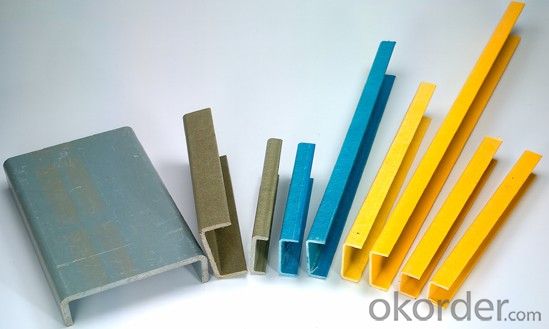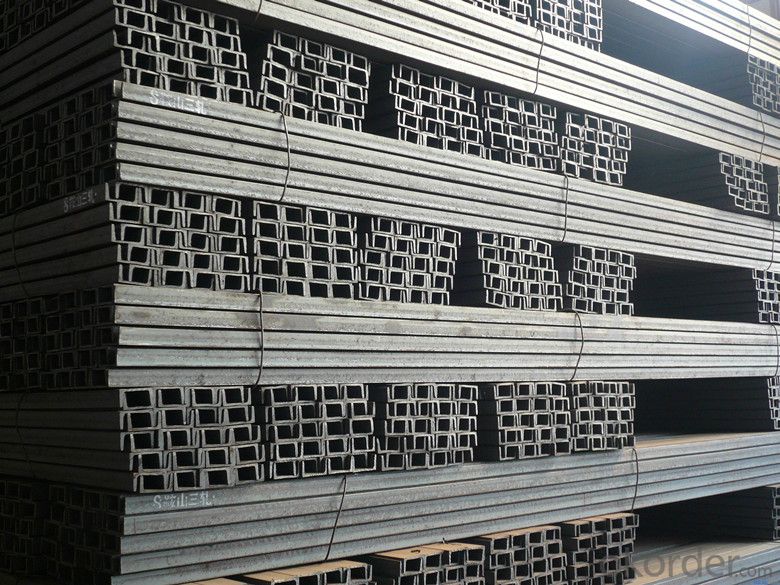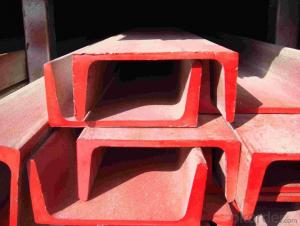Hot Rolled Galvanized Lip C Channel Steel Q195-Q235
- Loading Port:
- Tianjin
- Payment Terms:
- TT OR LC
- Min Order Qty:
- 4000 PCS
- Supply Capability:
- 38000 PCS/month
OKorder Service Pledge
Quality Product, Order Online Tracking, Timely Delivery
OKorder Financial Service
Credit Rating, Credit Services, Credit Purchasing
You Might Also Like
Hot Rolled Galvanized Lip C Channel Steel Q195-Q235 Details
| Standard: | AISI,ASTM,BS,DIN,GB,JIS | Dimensions: | 150*75*25*3.0mm | Grade: | carbon steel |
| Place of Origin: | China (Mainland) | Brand Name: | CNBM | Model Number: | 150mm*75mm*25mm*3.0mm |
| Shape: | C Channel | Application: | construction structure | Perforated Or Not: | Not Perforated |
| Grade:: | Q235,Q195,Q345,SS400,A36 | Length: | 3m, 6m, 9m, 12m, or as your request | Standard: | GB/ JIS |
| Size:: | 80*50mm--240*80mm | Surface:: | Perfect/ Galvanized/ oiled/ painted/ make holes | Technique: | Hot rolled/ cold rolled |
Packaging & Delivery
| Packaging Detail: | standard seaworthy packing or as your requirements. |
| Delivery Detail: | within 25- 35 days after signing the contract |
Hot Rolled Galvanized Lip C Channel Steel Q195-Q235 Specification
| Standard | AISI,ASTM,GB,JIS,DIN |
| Grade | Q195, Q215, Q235, ETC |
| Thickness | 1.0-4.0mm |
| Width | 30-350mm |
| Depth | 15-110mm |
| Lip Width | 10-30mm |
| Surface | Balce or Galvanized |
| usage | widely used in the purlin and wall beam of steel structure building, can be combined to make light weight roof truss, brecket, construction component, can be used in the production of beams and column, arm, in light industry machinery, etc. |
Hot Rolled Galvanized Lip C Channel Steel Q195-Q235 Pictures



- Q:How do steel channels perform in high-wind areas?
- Steel channels perform well in high-wind areas due to their strength and durability. The structural integrity of steel channels allows them to withstand the strong forces exerted by high winds, providing stability and resistance against potential damage or collapse.
- Q:What are the guidelines for steel channel installation in corrosive environments?
- When installing steel channels in corrosive environments, there are a few important guidelines to follow to ensure their longevity and effectiveness: 1. Material selection: Choose a steel material that is specifically designed to withstand corrosive environments. Stainless steel is often a suitable choice due to its high resistance to corrosion. Additionally, consider the grade of stainless steel that is most appropriate for the specific corrosive substances present in the environment. 2. Surface preparation: Properly prepare the surface of the steel channels before installation. This may involve removing any existing rust or corrosion, cleaning the surface thoroughly, and applying a protective coating or treatment to enhance the corrosion resistance. 3. Protective coatings: Apply suitable protective coatings to the steel channels to prevent corrosion. This could include paints, epoxy coatings, or galvanizing. Ensure that the chosen coating is compatible with the corrosive environment and offers long-term protection. 4. Proper drainage: Design the installation in a way that promotes proper drainage of any corrosive substances that may come into contact with the steel channels. This can help minimize the accumulation of corrosive agents and reduce the risk of corrosion. 5. Avoid contact with dissimilar metals: Avoid direct contact between the steel channels and dissimilar metals, as this can lead to galvanic corrosion. If contact cannot be avoided, use appropriate insulating materials or coatings to separate the metals and prevent galvanic corrosion. 6. Regular maintenance: Regularly inspect and maintain the steel channels to identify any signs of corrosion or damage. Promptly address any issues to prevent further deterioration and ensure the continued effectiveness of the installation. 7. Follow industry standards and recommendations: Familiarize yourself with relevant industry standards, guidelines, and recommendations for installing steel channels in corrosive environments. This can provide valuable insights on best practices and ensure compliance with safety and performance requirements. It is important to consult with experts or engineers who specialize in corrosion control to ensure that the guidelines are tailored to the specific corrosive environment and the intended application of the steel channels.
- Q:What are the different surface finish options for steel channels?
- Some common surface finish options for steel channels include hot-dip galvanized, powder coated, painted, and bare steel.
- Q:Can steel channels be used in sports facilities?
- Yes, steel channels can be used in sports facilities. Steel channels are commonly used in the construction of sports facilities such as stadiums, arenas, and gymnasiums. They provide structural support for various components such as overhead lighting, scoreboards, and seating systems. Steel channels offer strength, durability, and flexibility, making them an ideal choice for sports facility construction.
- Q:Can steel channels be used for sign supports?
- Yes, steel channels can be used for sign supports. Steel channels are commonly used in construction for their strength and durability, making them suitable for supporting signs.
- Q:How are steel channels protected during transportation and storage?
- To ensure the quality and prevent damage of steel channels, various measures are taken during their transportation and storage. Protective coatings or finishes, such as paint or galvanizing, are commonly used to create a barrier between the steel channels and the external environment, thereby preventing corrosion and rusting. During transportation, steel channels are securely bundled and fastened with straps or chains to prevent any movement or potential damage. They may also be placed in crates or containers to provide additional protection and avoid any impact from external forces. For storage, it is important to keep the steel channels in a dry and well-ventilated area to avoid exposure to moisture. Stacking them on pallets or racks helps to prevent direct contact with the ground and minimizes the risk of damage. Moreover, storing them in a covered area or using weatherproof covers provides further protection against precipitation and other weather elements. Regular inspections are crucial throughout transportation and storage to detect any signs of damage or deterioration. This allows for prompt repairs or replacements to be carried out, ensuring that the steel channels remain in optimal condition. In conclusion, proper protective measures, including coatings, secure bundling, appropriate storage conditions, and regular inspections, are indispensable for safeguarding steel channels during transportation and storage, thereby preserving their quality and preventing potential damage.
- Q:Can steel channels be painted or coated?
- Steel channels have the ability to be painted or coated. The act of painting or coating steel channels has multiple purposes, which include improving their visual appeal, shielding them from corrosion, and increasing their durability. Prior to the painting or coating process, it is necessary to adequately prepare the channels by cleaning them, removing grease, and eliminating any rust or impurities. Once the preparation is complete, various methods can be employed to paint the channels, including brushing, spraying, or dipping. Coatings can also be administered through procedures such as electroplating or hot-dip galvanizing. The selection of paint or coating is dependent on specific requirements and desired outcomes, such as anti-corrosion properties, resistance to weather conditions, or fire resistance. In conclusion, painting or coating steel channels is a widely practiced and effective technique to enhance their appearance and extend their lifespan.
- Q:Which is cheaper, the same size, ordinary channel steel and light channel steel? Price difference is not big?
- Light channel steel and ordinary channel compared to the same height, other sizes are thinner than ordinary channel, the natural weight is lighter.
- Q:How can channel A and B be distinguished?
- Of the same height, type B has wider legs and thicker waist than A.
- Q:What is the weight of a standard steel channel?
- The weight of a standard steel channel can differ based on its dimensions and the type of steel utilized. Nevertheless, a rough estimate can be provided. For instance, a standard steel channel measuring 6 inches by 8.2 pounds per foot (6x8.2) would generally weigh approximately 8.2 pounds per foot. It is worth mentioning that this is merely an approximation and actual weights may slightly differ. Moreover, if you have specific dimensions or a particular type of steel channel in mind, supplying those details would aid in a more precise weight calculation.
1. Manufacturer Overview |
|
|---|---|
| Location | |
| Year Established | |
| Annual Output Value | |
| Main Markets | |
| Company Certifications | |
2. Manufacturer Certificates |
|
|---|---|
| a) Certification Name | |
| Range | |
| Reference | |
| Validity Period | |
3. Manufacturer Capability |
|
|---|---|
| a)Trade Capacity | |
| Nearest Port | |
| Export Percentage | |
| No.of Employees in Trade Department | |
| Language Spoken: | |
| b)Factory Information | |
| Factory Size: | |
| No. of Production Lines | |
| Contract Manufacturing | |
| Product Price Range | |
Send your message to us
Hot Rolled Galvanized Lip C Channel Steel Q195-Q235
- Loading Port:
- Tianjin
- Payment Terms:
- TT OR LC
- Min Order Qty:
- 4000 PCS
- Supply Capability:
- 38000 PCS/month
OKorder Service Pledge
Quality Product, Order Online Tracking, Timely Delivery
OKorder Financial Service
Credit Rating, Credit Services, Credit Purchasing
Similar products
New products
Hot products
Related keywords



























